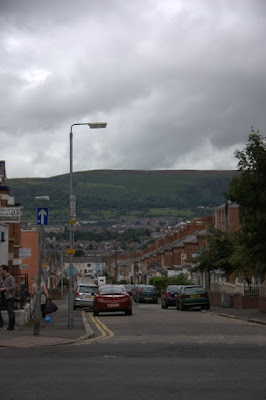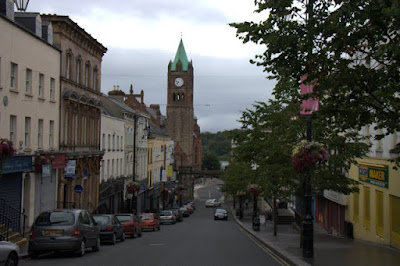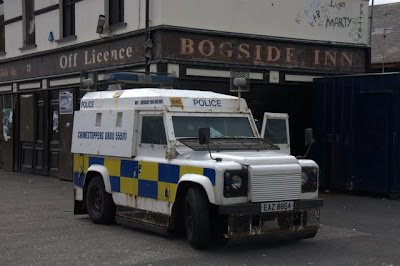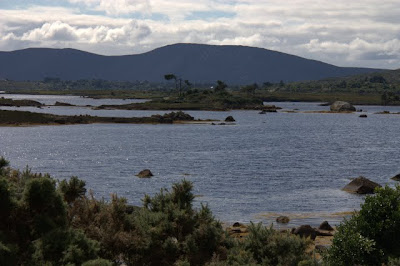Belfast
I felt a connection to Belfast. Tough and blue-collar, in some ways it reminded me of Pittsburgh, my hometown.
It has neighborhoods with small, brick, working-class houses; university neighborhoods with tree-lined streets; neighborhoods with trendy shops.
Unlike Pittsburgh, Belfast’s predominant industry still exists today. They built the Titanic in Belfast, and still build ships today. All the tourist brochures mention the Titanic, and we saw t-shirts with the slogan “she was fine when she left.” That may be true, but I’m not sure I’d brag about building the Titanic.
Touring the Antrim Coast
The northernmost coast of Northern Ireland, somewhat in between Derry and Belfast, is known as the Antrim Coast. In certain spots, it is only 12 miles away from Scotland. The coast is chock full of goodies, not even counting the many random places we stopped to take in the view. I don’t normally bore you with a play by play of our days, but some days are so awesome they are worth checking out step by step. Come along on a tour with us:
1. First up is Dunluce Castle. Perched on cliffs that tower over the sea, the castle has lain in ruins since it was pillaged in the 16th century. If you own the actual record recording of Led Zeppelin’s Houses of the Holy, flip open the album. The picture in the centerfold is Dunluce Castle. When I was younger, I hung the album cover open to the center picture on my bedroom wall, never realizing that I would someday visit the castle depicted.
2. Next, we toured Bushmill’s Distillery. Naturally, the perfect start to a day of driving is drinking whisky. Since neither of us are whisky fans, we just tasted small amounts of the 10 and 12 year reserves. Smooth, but not smooth enough.
3. Then, we took a short walk along the ocean to visit the most visited attraction in Northern Ireland: Giant’s Causeway. The causeway is a bizarre series of basalt formations. The most famous part is the formations that are shaped like octagons (?) and jet out of the ground at various lengths. Flat on top, you can hop from one to the other. Legend has it that they were created by Finn McCool, a giant who used them as stepping stones to get to Scotland to resuce his Scottish love. The Causeway was rather crowded when we visited, but a really cool sight nonetheless. Again, please refer to your Houses of the Holy album cover. The controversial picture on the front of naked children climbing on rocks is the Giant’s Causeway. I had no idea when we decided to tour the coast that I would see places I had seen before in these pictures.
4. After Giant’s Causeway, we stopped at a cute gift shop in a sheep pasture to buy a certain sister’s 30th birthday gift (Happy Birthday, Julie!).
5. Then, despite a certain nameless someone’s dislike of heights, we crossed the Cede-a-Carrick rope bridge. Spanning a chasm 30-metre deep and 20-metre wide, high above the Atlantic Ocean, the rope bridge was originally used by salmon farmers for better access to the ocean. The views were spectacular.
6. Our last stop is 20 km south of the coast, to a lane in a small farm village. You’ll have to excuse our stop for a cow crossing, but this is farm country. You may be wondering why we are veering away from the coast. We’re lured by the Dark Hedges, an enchanting country road covered by intertwining trees.

And that’s the Antrim Coast. Pretty fantastic, huh?
Did she say what we thought she said?
The big news in Derry was that it had been named the UK City of Culture for 2013 shortly before we arrived. I wish I could paint a picture of Derry as the tourist brochures do: modern and cutting edge and the only city in Europe to be encircled by fully intact historic city walls. No mention of any problems.
But one can’t deny that Derry is still a conflicted city. Residents cannot even agree on its name. Derry should have been part of Ireland when the British took over Northern Ireland, but due to its economic success, the British reached around the river border to include it in Northern Ireland. The result is that some people call it Derry, its Irish name; others call it Londonderry, its British name. (Derry is its official name, but even on maps, you will see it both ways).
When we arrived in Derry, road blockages forced us to take a detour to the B&B at which we planned to stay. As we tried to navigate around, we passed a police vehicle with grates and armored sides that looked more like a military vehicle than anything else. Did you see that? They’re hard core here, I remarked to Sean.
After checking in at the B&B, we walked to the center city to get something to eat. It was eerily quiet on our walk there. We didn’t pass many people, and when we arrived in the center, everything looked deserted. When the hosts at our B&B gave us recommendations for dinner at the B&B, they mentioned a pedestrian-only street. We pictured something quaint, but what we saw was a street partitioned from the streets with traffic with barricades. Wow, is this town dead, one of us said. Maybe because it is Sunday?, the other suggested.
We found the recommended restaurant and had a nice dinner. We took a taxi back to the B&B, and asked the taxi driver if things were always this quiet. He mumbled something about things being busier on the weekends. When we got back to the B&B, we were talking to our host about the problems we were having connecting to the internet. Oh, she said, we’ve been having trouble with the internet all day since the bomb this morning. She kept talking, but I didn’t hear what else she said after that. It was hard to tell with her accent and all, but I was pretty sure she said bomb. I looked at Sean. From the expression on his face, I was pretty sure he was pretty sure she said bomb too. Did you say… I trailed off. Bomb? Sean finished for me. Oh. Her face fell. You didn’t hear? No, we said in unison. Oh, she said, in an offhand fashion, just some small minded individuals being stupid. No one was hurt.
She continued talking about the problems with the internet. I wanted to know more about this bomb. I wasn’t sure whether she was trying to play off the bomb as no big deal because she didn’t want to scare away potential business or because something like this was a common occurrence. Sean and I pressed her for more information, and found out that a splinter group of the IRA had hijacked a taxi driver around 3 a.m. that morning, held him at gunpoint while he drove to the police station and planted the bomb at the police station. Luckily, no one was hurt. According to our host, this sort of thing hadn’t happened in a while, but every once in a while “small-minded” people who do not have the support of the community liked to stir up trouble. She said this type of activity used to be supported by some people, but these days everyone wants to move past it.
This whole bomb thing explained a lot: why the road was barricaded off (it was the road where the police station was located), why downtown was dead and barricaded.
The next day, we visited the Bogside, a predominantly Irish/Catholic/Republican neighborhood. (Republicans believe that the Republic and Northern Ireland should be united as one whole, and believe they have been discriminated against and oppressed by English rule). The Bogside is a neighborhood with a past; it was the scene of much violence. It is where Bloody Sunday occurred in 1972; 14 people were killed when British soldiers opened fire on an otherwise peaceful protest about civil rights and discrimination against Catholics.
The reason we visited the Bogside, as many tourists to Derry do, was to see the political murals. All of the murals are large, imposing, dominant; some are menacing, some are peaceful and in remembrance. They are painted right on the side of buildings containing housing. As an outsider, it is hard to understand how people can move on with their lives when they have to walk by the murals every day, right in their neighborhoods. For them, do they blend in just as much as lawn decorations? Or are they a constant reminder about what happened? Yet you can’t just paint over them, and erase the past.

I found it sad that years after the ceasefire, there were bombs being set off, even if it was by a small minority without community support.
That there were police, with military-like vehicles, and machine guns, standing right next to the mural in remembrance of those who died on Bloody Sunday.
That the planting of a bomb is not necessarily an isolated incident. That we as tourists can’t focus on the Derry presented in the brochures. That people are still resorting to past methods instead of focusing on the future.
Note: Unlike Australia, the United States State Department has not declared a formal travel warning about travelling to Northern Ireland, but does urge travelers to use caution. While occasionally incidents like the bomb that was planted the morning we arrived do crop up from time to time, overall it is fine to travel to Derry. You may want to check the latest travel warnings before you go.
Northern Ireland
I suppose I knew that Northern Ireland was part of the United Kingdom and a completely different country from the Republic of Ireland – I even wrote a paper in college about the Troubles – but it wasn’t a fact I focused upon. I sort of just lumped both countries together into one amorphous concept called Ireland until we visited Northern Ireland. You don’t realize right away that you are in a different country when you cross the border. Many things are the same as the Republic: the pubs with Guinness signs outside; the sheep, Guinness, and shamrock merchandise in the tourist shops; the chatty people – they’re all there. But the British influence is undeniable.
First of all, there’s the different currency thing. If Americans get screwed when using the euro, the pound is even worse. Although the exchange rate is down considerably from a couple of years ago, everything costs us almost 60% more than it would at home. And it didn’t always seem like prices were adjusted accordingly, which meant that if we were paying 4 euros for a pint of Guinness down south, we now were paying 4 pounds. We lost track of our budget in the Republic sometime after the second round of Guinness, and we certainly weren’t going to make up any lost ground in Northern Ireland.
Second, there’s the accents. The Irish brogue down south was challenging sometimes, but always decipherable. The accents up north are thick; somewhere between an Irish brogue and the English lilt. It is a toss-up who was the hardest to understand: the woman at our B&B in Derry or the farmer in County Armaugh. I think the farmer wins. Even though he was speaking English, we only comprehended every third word. Other guests at the farmhouse told us to listen faster in order to figure out what he was saying.
Third, it just looks different. Northern Ireland feels more compact and congested than the south. Even when you are in farmland, cities and towns are not far away. There are less pubs and more bars (for whatever the difference is).
Then there’s the whole matter of the Troubles. There was no mention of the Troubles when we were travelling through the Republic, but it is impossible to ignore the conflict when travelling through Northern Ireland. The relationship between Northern Ireland, the Republic and Great Britain is long, complicated, and intertwined. In a nutshell, the conflict has to do with politics, religion, roots, nationalism, poverty, discrimination, violence, and pride. As an outsider, it seemed to me that Northern Irelanders are trying to heal and move past the Troubles, but the scabs over the wounds are tenous. The tourism board is trying hard to divert everyone’s attention away from the past. The slick, trendy brochures focus on what is going on in the country’s present, with only scant references to the history. But we saw reminders of the Troubles with our own eyes: the British flags that fly to display loyalty to the crown; the Irish colors painted on lamp posts and curbs; the attempted violence that is still occurring; the pieces of car bomb in the ground on a farm; the uneasiness when one strays into the neighborhood of the others; the imposing murals that dominate the neighborhoods; and the gate dividing the Catholic/Republican and Protestant/Unionist neighborhoods that is still locked every night.
Of course, Northern Ireland is so much more than the problems they have had in the past. The all too recent history is fascinating to learn about, but Northern Ireland has beauty, warmth, and attractions in its own right. I was glad we made the decision to travel there; it presented a whole picture and clarified the amorphous Ireland in my mind.
p.s. Hope everyone in the states is having a happy and fun Labor Day weekend!
Boglands
West of Galway is the Connemara, an area of Ireland that looks completely different than the rest.
The greens are not as vibrant, but wildflowers grow in abundance and add an accent color we didn’t see elsewhere. This is the land of bogs.
In every direction is a new scenic drive: pockets of water in between rocky landscapes; sea cliffs and coast line; the Twelve Pins mountain range; and, of course, sheep.
We stayed in Clifden, a quaint little town where we caught some live music (complete with a guy playing a box drum).
Then we moved on to Westport, which I would describe as sophisticated with the glaring exception of our accommodations.
Everything was expensive, so we ended up taking a room in the back of a pub. The bathroom smelled so strong of mildew that we had to keep the door shut for fear that it would infiltrate the room. We both decided to forgo showering and just held our breath when our bladders finally demanded that we use the facilities. It was one of the few nights I had to use the sleep sack. Fun times.



































